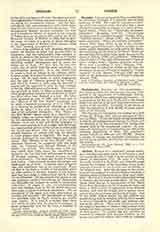

Cochem, MARTIN OF, a celebrated German theologian, preacher and ascetic writer, b. at Cochem, a small town on the Moselle, in 1630; d. in the convent at Waghausel, September 10, 1712. He came of a family devotedly attached to the Faith, and while still young entered the novitiate of the Capuchins, where he distinguished himself by his fervor and his fidelity to the religious rule. After his elevation to the priesthood, he was assigned to a professorship of theology, a position which for several years he filled most creditably. However, it was in another sphere that he was to exercise his zeal and acquire fame. Of the evils which befell Europe in consequence of the Thirty Years War, the plague was by no means the least, and when, in 1666, it made its appearance in the Rhenish country, such were its ravages that it became necessary to close the novitiates and houses of study. Just at this crisis, Father Martin was left without any special charge and, in company with his fellow monks, he devoted himself to the bodily and spiritual comfort of the afflicted. What most distressed him was the religious ignorance to which a large number of the faithful had fallen victims on account of being deprived of their pastors. To combat this sad condition, he resolved to compose little popular treatises on the truths and duties of religion, and in 1666 he published at Cologne a resume of Christian doctrine that was very well received. It was a revelation to his superiors, who strongly encouraged the author to continue in this course.
Thenceforth Father Martin made a specialty of popular preaching and religious writing and, in the Archdioceses of Trier and Ingelheim, which he traversed thoroughly, multitudes pressed about him, and numerous conversions followed. The zealous priest continued these active ministrations up to the time of his death, and even when he had passed his eightieth year he still went daily to the chapel of his convent, where, with the aid of an ear-trumpet, he heard the confessions of the sinners who flocked to him. The intervals between missions he devoted to his numerous writings, the most voluminous of which is an ecclesiastical history in 2 vols. fol., composed for apologetic purposes and provoked by the attacks made upon the Church by Protestantism. However, the author brought it down only to the year 1100. Father Martin‘s other works embrace a great variety of subjects: the life of Christ, legends of the saints, edifying narratives, the setting forth of certain points in Christian asceticism, forms of prayer, methods to be followed for the worthy reception of the sacraments, etc. These widely different themes have as points of similarity a pleasing, graceful style, great erudition, and a truly seraphic eloquence. They bespeak for their author sincere piety and deep religious sentiment, coupled with an intimate knowledge of the popular heart and the special needs of the time. But the best known of all the learned Capuchin’s works is unquestionably “Die heilige Messe”, upon which, according to his own statement, he spent three entire years, perusing Holy Writ, the councils, Fathers and Doctors of the Church, and the lives of the saints, in order to condense into a small volume a properly abridged account of the Holy Sacrifice. As soon as it appeared this book proved a delight to the Catholics of Germany, nor has it yet lost any of its popularity, and, since its translation into several languages, it may be said to have acquired universal renown.
It demanded a great expenditure of energy on the part of the worthy religious to bring these undertakings to a successful issue. Even when in his convent he spent most of the day in directing souls and following the observances prescribed by the Capuchin Rule, hence it was time set aside for sleep that he was wont to give to his literary labors. Sometimes after the Office of Matins he would obtain permission of the superior to go to Frankfort to confer with his publisher and, this accomplished, he would return on foot to his convent at Konigstein, catechizing little children, hearing confessions, and visiting the sick along the way. While still in the midst of his labors he was attacked by an illness to which he soon succumbed, at the age of eighty-two. The works published during Father Martin‘s lifetime are: “Die Kirchenhistorie nach der Methode des Baronius and Raynaldus bis 1100” (Dillingen, 1693): “Die christliche Lehre”; “Heilige Geschichten and Exempel”; “Wohiriechender Myrrhengarten” (Cologne, 1693); “Btichlein fiber den Ablass” (Dillingen, 1693); “Exorcismen and fur Kranke” (Frankfort, 1695); “Goldener Himmelsschlissel” (Frankfort, 1695); “Gebetbuch fur Soldaten” (Augsburg, 1698); “Anmuthungen wahrend der heiligen Messe’ (Augsburg, 1697); “Die Legenden der Heiligen” (Augsburg, 1705); “Leben Christi” (Frankfort, 1689; Augsburg, 1708); “Gebete unter der heiligen Messe” (Augsburg, 1698); “Kern der heiligen, Messe7f (Oologne, 1699); “Liliengarten” (Cologne, 1699); “Gebetbuch fur heilige Zeiten” (Augsburg, 1704); “Die heilige Messe fur die Weltleute” (Cologne, 1704); “Traktat fiber die gottlichen Vortreffhchkeiten” (Mainz, 1707); “Geistlicher Baumgarten” (Mainz and Heidelberg, 1709); “Neue mystische Goldgruben” (Cologne, 1709); “Exemepelbuch” (Augsburg, 1712). This list does not include all of the author’s writings. In 1896 there appeared a small work never before published, “Das Gebet des Herzens”, which at the end of its third year went into a seventh edition.
F. CANDIDE

